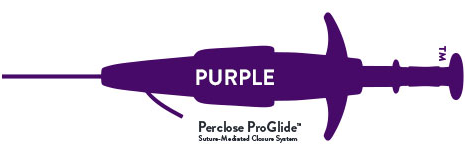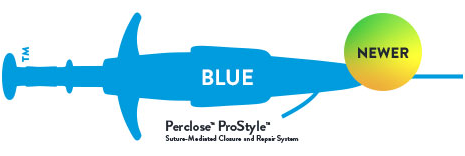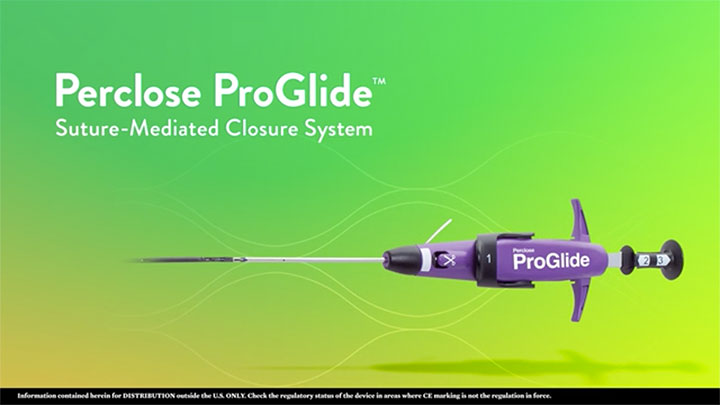Suture-Mediated Closure For Both Femoral Arterial And Venous Access Sites
The Perclose ProGlide™ Suture-Mediated Closure (SMC) System is part of the Perclose™ Family of products, which offer a COMPREHENSIVE, VERSATILE, and PROVEN solution for hemostasis management unrivaled by any other single offering. That's why the Perclose™ Devices are the world's leading vascular closure system.†
Each Perclose ProGlide™ SMC System delivers a pretied suture to the femoral access site to:
- Enable Immediate and durable hemostasis1
- Reduce a patient’s time to ambulation and discharge2,3
- Lower access site-related complications2,3,4
Comprehensive
Breadth of Transfemoral Applications
- The broadest arterial and venous indication among all vascular closure devices on the market*
- Arterial Sheaths 5-21F1,5
(Max OD 26F)7 - Venous Sheaths 5-24F1,6
(Max OD 29F)7

Max. OD 26F/0.340 inches/8.62 mm; Max. OD 29F/0.378 inches/9.59 mm. Data on file at Abbott.
Versatile
Keep Your Options Open
Before the Procedure
Customize your closing approach by deploying the sutures before the procedure (pre-close) or after the procedure (post-close), by using one or more devices per access site1
During the Procedure
Maintain guide wire access even after deployment of the Perclose™ sutures to keep all therapeutic options open.1
After the Procedure
Pull the sheath sooner due to no ACT-level requirements, and re-puncture the same access site immediately or in the near-term since Perclose™ Devices have no reaccess restrictions.1
Proven
Established Decades-Long Track Record
- Robust Clinical Evidence on the safety and efficacy of both venous and arterial access site closure.2,3,4
- 20,000,000+ closures and counting across 100+ countries worldwide8,9
For EP labs, click here to discover how Perclose ProGlide™ SMC System can improve EP lab workflow and enhance the patient experience.
Primary Intention healing through tissue approximation10:
Suture-Mediated Closure

Access the Vessel
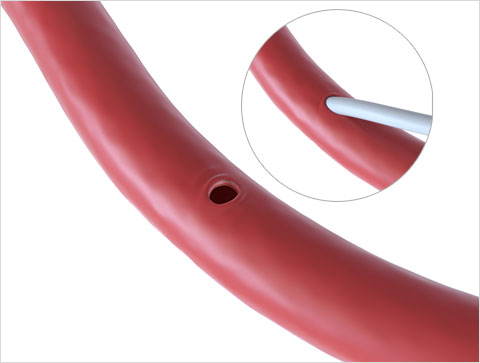
Close the Access Site
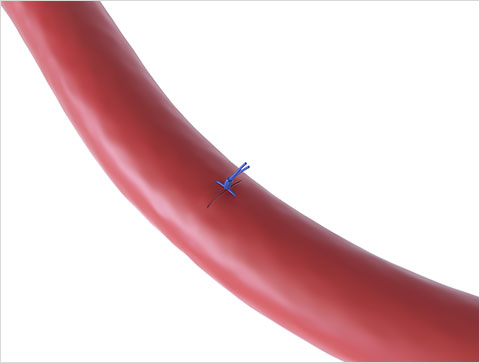
Heal the Vessel

Perclose™ Knot Animation
Frequently Asked Questions
Are the indications the same between Perclose™ ProStyle™ and Perclose ProGlide™?
Yes, the indications are identical between Perclose™ ProStyle™ and Perclose ProGlide™ and each device can be used after the same types of percutaneous transfemoral procedures. These Perclose™ devices still maintain the broadest indication* amongst vessel closure devices in the market:
- Arterial Sheaths 5-21F1,5 (Max OD 26F)7
- Venous Sheaths 5-24F1,6 (Max OD 29F)7
Will Perclose ProGlide™ be discontinued?
The Perclose™ ProStyle™ SMCR System is the next-generation design evolution of the proven and trusted Perclose ProGlide™ SMC System, and it has been improved based on years of customer input and feedback. Although the conversion will take a few years, the updated Perclose™ ProStyle™ SMCR System is an overall better device and we should want our customers to make the switch for improved reliability, enhanced usability, and a more intuitive deployment experience.
What features of Perclose™ ProStyle™ have been updated to improve the reliability and performance over that of Perclose ProGlide™?
Stronger Needles in Perclose™ ProStyle™8
- Designed to reduce the frequency of needle deflection in more complex challenging anatomy, resulting in cuff misses
Reduced Plunger Spring force8
- The Plunger spring force was reduced to eliminate Plunger rebound and improve needle-to-cuff engagement at the end of Step 2 (Depressing the Plunger to Deploy the Needles)
Lubrication added to the Cuffs of the Foot8
- Lubrication has been added to the anterior and posterior cuffs of the Foot to reduce the overall deployment force required to depress the Plunger and deploy the Needles.
What makes the needles in Perclose™ ProStyle™ stronger? What is the impact of stronger needles during deployment?
- The material of the anterior and posterior needles of Perclose™ ProStyle™ was changed from the normal Stainless Steel (used in Perclose ProGlide™) to a custom High Tensile Stainless Steel with 11-16% increased needle strength to minimize needle deflection and improve needle penetration through less compliant anatomy.8
- The higher tensile strength needles in Perclose™ ProStyle™ minimize needle deflection, reduce cuff misses and improve needle penetration through complex, challenging and less compliant anatomy.8
- During benchtop testing, Perclose™ ProStyle™ demonstrated a 15% improved success rate of suture deployment over that of Perclose ProGlide™ for better reliability and performance in more complex, challenging and less compliant anatomy.8
What features have been added to the Perclose™ ProStyle™ SMCR system to increase ease of use and ease of learning?
Matching Depth Reference Markers8
- New matching Depth Reference Markers have been added to the Perclose™ ProStyle™ device and Suture Trimmer to provide an optional visual estimation of the access site depth
- The distance between the center of each Depth Reference Marker is exactly 1 cm apart and are easy to see, thus improving ease of learning and ease of use
Guide Wire Exit Port8
- The Guide Wire Exit Port is the same as that of Perclose ProGlide™, however, the printing area surrounding the Guide Wire Exit Port has been increased by 329%
- This modification of the printing design improves visibility of the Guide Wire Exit Port and can improve the ease and efficiency of regaining guide wire access
QuickCut™8
- The opening area of QuickCut™ has been redesigned by increasing the suture capture area by approximately 39% to facilitate easier and more efficient suture capture and trimming of the suture at the end of Step 3 (Pull the Plunger back to deploy the Sutures)
Thumb Knob and Suture Gate8
- The Thumb Knob and Suture Gate on the updated Perclose™ ProStyle™ Suture Trimmer have been updated with matching white colors to improve ease of use and ease of learning when opening the Suture Gate
- When the white Thumb Knob is retracted, the white Suture Gate opens, providing a more intuitive experience when using the Suture Trimmer
Trimming Lever and Suture Trimmer Blade8
- The spring rate on the red Trimming Lever has been increased to reduce the potential for accidental trimming
- The Suture Trimmer Blade design was modified to remove a laser cut force reduction feature on the shaft, improving cutting efficiency and tactile feedback during trimming for improved ease of use
Perclose Snared Knot Pusher8
- This accessory knot advancement provides an alternative option to the Suture Trimmer with a tapered shaft for easier insertion, a longer working length for deeper tissue tracts, and concave tip that sits on top of the knot for more tactile knot advancement
White-tipped Non-Rail8
- The white marking on Non-Rail suture limb is created by using a shrink tubing on the end of the suture limb
- The amount of white pigment in the shrink tubing has been increased by 250% to provide better contrast and differentiation from the blue Rail suture limb and ease the visual identification of the white-tipped Non-Rail suture limb.
Additional hydrophilic coatings8
Perclose™ ProStyle™ device
- The tapered Sheaths of both Perclose ProGlide™ and Perclose™ ProStyle™ are coated with the same hydrophilic coating
- With Perclose™ ProStyle™, the same hydrophilic coating has been extended up to coat Distal Guide as well, to further ease device advancement by reducing the insertion force required when advancing the device into the body8
- During benchtop testing, the mean coefficient of kinetic friction at the Distal Guide was 27% lower for Perclose™ ProStyle™ compared to Perclose ProGlide™, allowing for improved ease of device advancement8
Perclose ProStyle Suture Trimmer
- A hydrophilic coating has also been added to the Sheath of the Perclose™ ProStyle™ Suture Trimmer for improved ease of use during knot advancement through the tissue tract8
References
†As of September 2024, per global market share data on file at Abbott.
*As compared to Angio-Seal‡, ExoSeal‡, FemoSeal‡, InClosure‡, MANTA‡, Mynx‡, PerQseal‡, Vascade‡, Velox CD‡, X-Seal‡. Data on file at Abbott.
- Perclose ProGlide™ SMC System – Instructions for Use (IFU). Refer to IFU for additional information.
- Fabbricatore D et al. (2023) Ambulatory PV isolation workflow using suture-mediated vascular closure devices: a prospective observational cohort study. (PRO-PVI Study). Europace. 25(4):1361-1368
- Schneider, DB et al. Clinical and economic outcomes of ProGlide compared with surgical repair of large bore arterial access. Journal of comparative effectiveness research, [s. l.], v. 8, n. 16, p. 1381–1392, 2019.
- Kar S, Hermiller J et al. The use of Perclose ProGlide SMC System for Venous Access-Site Closure up to 24F Sheaths. CRT 2018 Poster.
- For arterial sheath sizes greater than 8F, at least two devices and the pre-close technique are required.
- For venous sheath sizes greater than 8F, at least one device and the pre-close technique are required.
- Max. OD 26F/0.340 inches/8.62 mm; Max. OD 29F/0.378 inches/9.59 mm. Data on file at Abbott.
- Data on file at Abbott.
- July 2024 Finance Report. Data on file at Abbott.
- Primary intention healing occurs where vessel wall edges are brought together, adjacent to each other. This can be achieved with suture, stitches, staples and clips. Advances in Skin & Wound Care: Healing by Intention. Salcido, Richard. 2017.
MAT-2507347 v1.0

